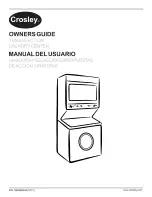
For Customer Services & Spare Parts please call
0345 208 8750
Opening times: Monday - Friday 8am – 8pm & Saturday 9am – 1pm
or visit us at
www.productcare.co.uk
15
Usage
Wine storage problems
Corking -
a tiny percentage of bottled wine (about 1%) will suffer from this. The
cork reacts with the wine and gives it a musty, unpleasant taste. It is the most
common wine storage problem and is caused by harmless bacteria growing on the
cork. As unfortunate as this is, there is nothing to do but to discard all of the wine
in the affected bottle. This is not to be confused with small fragments of cork
floating in the wine itself, which will not impair the flavour.
Oxidisation -
when wine has been opened and left for longer than a day; it tends
to lose its aroma and colour, giving an overall flat taste. The only way to avoid this,
it to either drink the wine on the same day it was opened or to use a vacuum
device specially designed for removing oxygen from opened wine bottles. If you
use such a device, the wine should still be consumed shortly afterwards.
Ullage -
this is loss of wine from the bottle by evaporation or leakage. Signs of
ullage include wine seeping around the cork, a protruding cork or a stained label. It
can happen if the bottle has been allowed to get too warm. The wine may still be
drinkable, if the leakage was recent; however, you should be aware that if the
wine cools down again, contraction can cause more air to be sucked into the
bottle and result in further deterioration.
Slight effervescence in still wine -
this isn’t really a problem with the way the wine
has been stored, but as a result of incomplete malolactic fermentation before the
wine was bottled. A good way to get rid of the effervescence is to let the wine
breathe. Alternatively you can use a bottle vacuum device, after about five
minutes the effervescence will vanish.
Sediment -
this is not normally a problem, however both red and white wines can
produce sediment after a number of months in a bottle. The sediment consists of
tartrate crystals and is totally harmless. If anything the building of sediment can be
considered a good sign because it means that the wine was not subjected to much
(if any) filtering, meaning that the flavours and aromas should be preserved
better.
















































